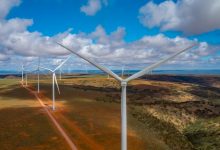It was a big week for South Australia last week. First, as we wrote at the time, the state reached 100 per cent solar power (of state demand) for the first time on Sunday, October 11.
Then, just a few days later, the state reached 100 per cent wind power (of state demand), on Thursday, October 15.
This was not the first time for wind, as it occurs reasonably often and for sometimes lengthy periods, but the fact that the two events occurred within days of the other are nevertheless important milestones. And although the transition to clean energy is far from complete, it does give some insight into what the state Liberal government’s target of “net 100 per cent renewables” by 2030 might look like.
It also came in a week when the state premier and energy minister formally opened construction of two significant projects in and around Port Augusta – including the country’s biggest wind-solar hybrid plant (317MW), and the 86MW second stage of the Lincoln Gap wind project, which is expected to grow to a total of 452MW.
We are indebted to Glenne Drover, from the Australian Institute of Energy, for noting the twin milestones and posting it on LinkedIn a few days ago.
It comes in a spring full of renewable energy and other records, at state and national level. The share of both wind and solar is reaching record levels, the share of renewables is above 30 per cent for the first time, and new minimum demand levels are being set in South Australia and Victoria, reflecting the growing influence of rooftop solar.
The commentary on Drover’s his post made for fascinating reading, and an insight into the state of the energy debate in Australia, and elsewhere for that matter.
It ranged from the those who moaned that solar couldn’t provide 100 per cent of the energy supply for 24 hours (apparently the sun goes down every evening, who knew?), to the energy trader from Shell who celebrated that gas also delivered 100 per cent of the state’s demand at one point (well, it didn’t quite, but nearly).
AEMO chief executive Audry Zibelman put it in some perspective, noting that the combination of rooftop solar (992MW) and large scale solar (313MW) fuelled the state’s electricity needs for a 30-minute period, a first in Australia and for any major jurisdiction globally.
She said the milestone affirms the world-leading scale and pace of transition underway in Australia’s power system.
“The domination and successful integration of rooftop solar in South Australia foreshadows the rebuilding of jurisdictional power systems in Australia,” Zibelman said in an emailed statement.
What the state will need is a lot more storage – either in the form of big batteries, virtual power plants or the numerous pumped hydro plants that have been mooted, but appear stuck in regulatory and policy limbo.
The case for storage was undermined by AEMO’s Mike Davidson, who in a comment on the LinkedIn post noted that “storage is next”, and also pointed to the key role that wind and solar played in keeping Victoria’s Portland smelter running when the main link between Victoria and South Australia was blown down in a storm earlier this year, and Victoria’s biggest load was hanging on to the end of the S.A. grid.









